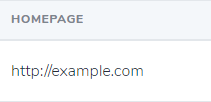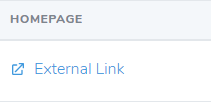Laravel Nova URL Field
A URL input and link field for Laravel Nova
Installation
Install the package into a Laravel app that uses Nova with Composer:
composer require inspheric/nova-url-fieldUsage
Add the field to your resource in the fields method:
use Inspheric\Fields\Url;
Url::make('Homepage')
->rules('url', /* ... */),The field extends the Laravel\Nova\Fields\Text field, so all the usual methods are available.
Supports readonly, placeholder and overriding the default type="url" if you prefer not to have the validation in the browser. This is from the standard Nova Text field so is not documented here.
It is recommended that you include the standard url and/or active_url validation rules, as they are not automatically added.
Options
Terminology: label, title, value
The terms "label", "title" and "value" are used to describe the following options. They should be understood within the generated HTML as follows:
<a href="{{ $value }}" title="{{ $title }}">{{ $label }}</a>
Label
Make the field display with a label instead of the URL value itself on the detail or index pages:
Url::make('Homepage')
->label('External Link'),You can, of course use the Laravel trans() or __() functions to translate the label.
The label is only displayed if the link is clickable, otherwise the URL value is displayed.
Label Using
Make the field display with a label using a callback:
Url::make('Homepage')
->labelUsing(function($value, $resource) {
return $this->title;
}),The arguments $value and $resource are passed in the same way as the callback for resolveUsing(), but are optional.
HTML Label
If you would like to use custom HTML for the label, remember to also use the asHtml() option.
Url::make('Homepage')
->label('<strong>External</strong> Link')
->asHtml(),Domain Label
A shortcut method to display the domain part only of the URL (i.e. without https?://www.) as the label:
Url::make('Homepage')
->domainLabel(),For example, the label for the field value https://www.example.com/path?query=value&another=true#fragment would display simply as example.com.
This is resolved after the displayUsing() callback if you have one, so if you modify the display of the URL in some way, the modified value will be passed to this label.
Name Label
A shortcut method to display the name of the field as the label:
Url::make('Homepage')
->nameLabel(),The label would be displayed as Homepage.
Title
Set the link's title attribute, which will be displayed when the mouse hovers over it:
Url::make('Homepage')
->title('Link title'),You can, of course use the Laravel trans() or __() functions to translate the label. If no custom title is set, the full URL value will be used.
The title is only used if the link is clickable.
Title Using
Set the title using a callback:
Url::make('Homepage')
->titleUsing(function($value, $resource) {
return $this->title;
}),Clickable
Make the field display as a link on the detail page:
Url::make('Homepage')
->clickable(bool $clickable = true),Clickable on Index
Make the field display as a link on the index page:
Url::make('Homepage')
->clickableOnIndex(bool $clickable = true),Always Clickable
Combination of the two functions above for simplicity:
Url::make('Homepage')
->alwaysClickable(bool $clickable = true),Open in Same Tab
By default, the clickable link will open in a new tab (using target="_blank"). You can modify this behaviour so that the link opens in the same tab:
Url::make('Homepage')
->sameTab(bool $sameTab = true),rel=noopener and rel=noreferrer
By default, a clickable link will open in a new tab and will have the rel=noopener attribute set*. If you use sameTab() as above, rel=noopener will be unset.
To override the default behaviour, you can choose to set or unset rel=noopener and/or rel=noreferrer with the following methods:
Url::make('Homepage')
->noopener(bool $noopener = true),
Url::make('Homepage')
->noreferrer(bool $noreferrer = true),If you use both sameTab() and noopener() on the same field, ensure that noopener() comes after sameTab() or the two settings will cancel each other out.
* See this article for an explanation.
Custom HTML
If you do not wish the link to be displayed with the default icon and text, you can set custom HTML which will replace the entire contents of the default template:
Url::make('Homepage')
->customHtml('<span class="my-class">Click here!</span>'),If the link is clickable, this content will be wrapped in an unstyled <a> tag which implements all of the other options you have specified, such as sameTab, title etc.
If you do want the link to appear as link-styled text, you can add the classes dim text-primary within the HTML you specify.
Important! It is your responsibility to escape or sanitize any user-provided data before displaying it as raw HTML. This package does not do that for you.
Custom HTML Using
Set the custom HTML using a callback:
Url::make('Homepage')
->customHtmlUsing(function($value, $resource, $label) {
return view('partials.link_text', [
'url' => $value,
'label' => $label,
])->render();
}),Note that the callback has a third argument $label, which will contain the appropriate label based on which of the label(), labelUsing(), nameLabel(), domainLabel() etc. options you have set on the field.
Remember that if the link is clickable, the custom HTML you specify is already wrapped in an <a href=""> tag, so you should not include an <a> tag in your own custom HTML.
Appearance
Index (default)
The field is displayed as a plain <span> element.
Index (clickable)
The field is displayed as an <a href="..."> element with an icon.
Index (clickable with label)
The field is displayed as an <a href="..."> element with an icon and a custom label.
Detail (default)
The field is displayed as a plain <span> element.
Detail (clickable)
The field is displayed as an <a href="..."> element with an icon.
Detail (clickable with label)
The field is displayed as an <a href="..."> element with an icon and a custom label.
Form
The field is displayed as an <input type="url"> element.









